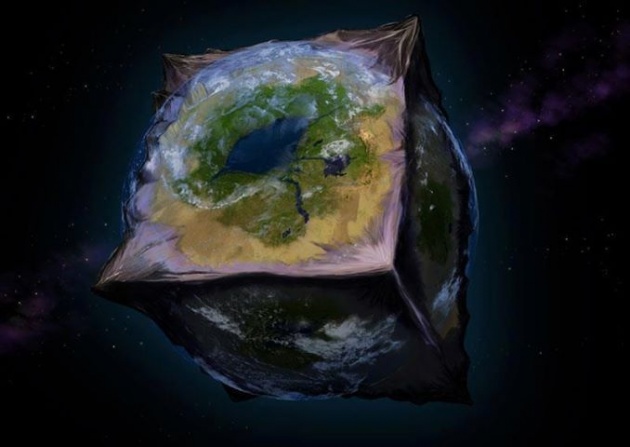 Back in 1884, a Swiss astronomer by the name of Arndt made headlines when he claimed to have discovered a very curious planet in an orbit beyond Neptune — a surprisingly cubical planet.
Back in 1884, a Swiss astronomer by the name of Arndt made headlines when he claimed to have discovered a very curious planet in an orbit beyond Neptune — a surprisingly cubical planet.
You know, like Bizarro World from the Super Man comics.
Of course even in 1884, everyone knew this was bunk. The New York Times even ran a piece titled “The Cubical Planet” in their Nov. 16 edition. As informative as it is stuffy, the Gilded Age article interviews physicist Dr. Theodore Vankirk, who first dismisses the prospect of a square planet as pure hooey, and then proceeds to wax scientific about just what a cube world would be like.
It all comes down to gravity. On our spherical Earth, gravity pulls “down” us toward the planet’s center of mass. So on a flat surface, we naturally stand up straight.
A hypothetical cube world, however, would feature six square faces and you’d only encounter up/down gravity toward the centers of these regions. As you traveled closer and closer to the edge, it would feel like you were walking up an incline and it would be difficult to stand up straight because the gravitational pull would draw you toward the center of the massive cube, which wouldn’t lie directly beneath your feet. Standing on the “edge” of this cube world would feel like standing atop a mountain range.
Contemporary cosmologist Dr. Karen L. Masters also finds the topic of cube worlds fascinating — especially the atmospheric possibilities. As she explains in Cornell’s Ask a Physicist feature, all six faces of the planet would boast temperate weather, centralized bodies of water and none of them would feature polar or equatorial weather. What’s more, the pointy edges of the cube would actually poke through the planet’s atmosphere like titanic mountains. Here’s her explanation:
Let’s assume that the atmosphere goes up 1000 km above the Earth (when it is a sphere), and so is a sphere itself of radius 6400km+1000km=7400km. This should be about the right number. A cube with the same volume as the spherical Earth would have a side 10,000 km (6,400 miles) long so the corners are 8700 km from the centre! They would definitely stick out above the atmosphere.
As I was poking around the net on this topic, I also ran across this amusing tidbit from a 1964 edition of the Rice University campus paper. A mysterious, well-dressed gentleman had been observed hanging out around the Houston-area campus, distributing literature about an alien, cubical planet.
The man claimed that the planet was called Aocicinori and that it was the 63rd in a system of 96 planets. He showed off maps of the world, as well as some colorful illustrations of the creatures that lived there. The Rice University article reveals that these materials were created by Scotland L. Moore, an outpatient form the Houston State Psychiatric Institute.
Source : Discovery News http://is.gd/P2ehSU
WHAT IF EARTH WAS A CUBE?
Posted on at



